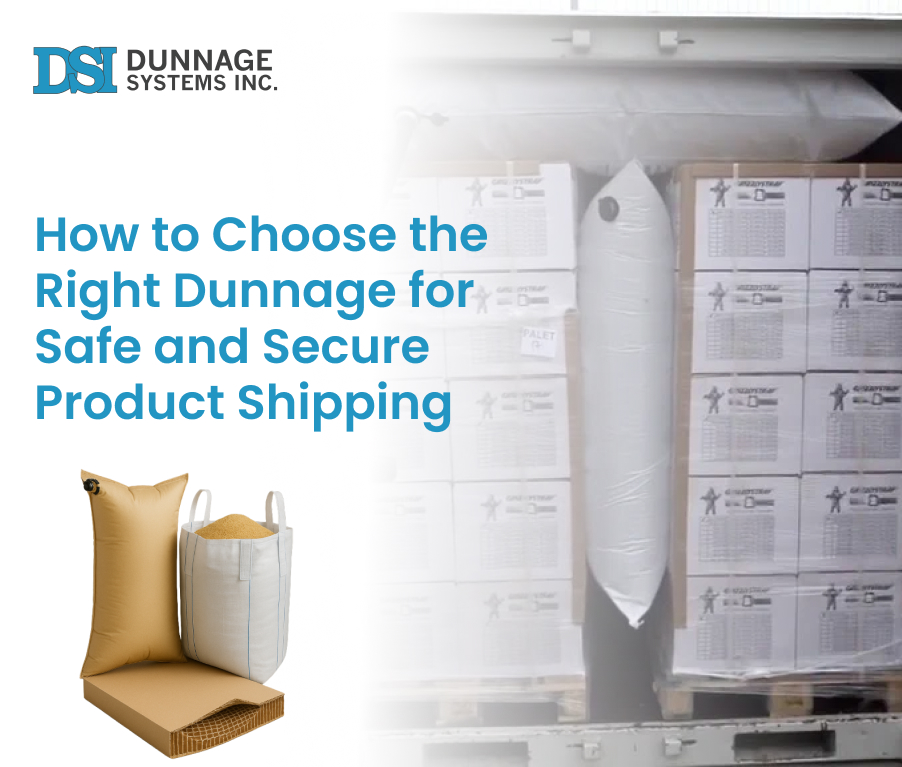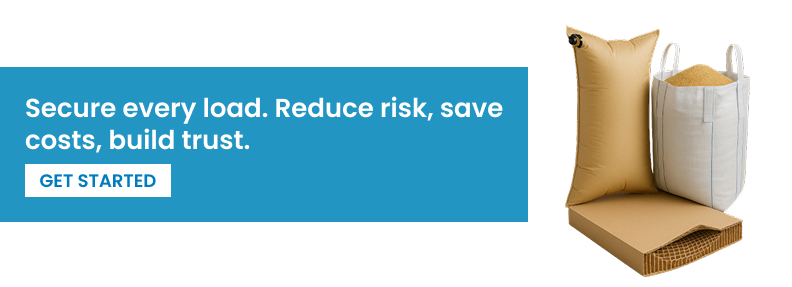Shipping safely is not just about a strong box or a trusted carrier. It is about what goes inside. That is where dunnage bags help.
There is no single answer about the right choice of dunnage bags. It depends on product fragility, shipping distance, cost, and your sustainability goals. When teams choose shipping air bags with care, they cut breakage and return. And they show customers they took packaging seriously.
In this guide, we will cover how to compare dunnage types, match them to your product, and keep shipments safe and cost‑effective.
Why the Right Dunnage Bags Are Critical for Modern Shipping
What Is Dunnage and Why Does It Matter in 2025
Dunnage bags, often called shipping airbags, are the packaging material that stabilizes and secures products with a cushiony effect and offers freight protection during transit. It is one of the most effective forms. Think bubble wrap, foam inserts, air pillows, and corrugated pads. They fill empty spaces in containers, brace cargo, and stop loads from shifting. The right choice can be the difference between “arrived fine” and “arrived damaged.”
In 2025, the role of dunnage is more important as shipping is tougher. Global supply chains are longer, and loads are bigger. Customers’ expectations are also sharper.
Dunnage airbags prevent:
- Damage from impact or vibration
- Shifting of cargo inside trucks, ships, or railcars
- Contamination from dust, moisture, or contact with other goods
Avoid costly mistakes. Explore How to Choose the Right Dunnage Air Bags Suppliers: Key Factors to Consider
The Cost of Poor Load Securement
When cargo is not properly secured, the risks multiply. Businesses face:
- Product damage that leads to wasted inventory
- Insurance claims that raise costs and slow operations
- Customer dissatisfaction when deliveries arrive broken or late
“Improper load securement causes billions in losses each year. According to FMCSA data, violations can cost fleets up to $185,000 annually.”
Types of Dunnage and Their Use Cases

Inflatable Options: Dunnage Airbags and Airbag Inflator Systems
- Stabilization in transit: Dunnage bags fill gaps and brace cargo in trucks, containers, and railcars. This cuts the risk of shifting.
- Rapid deployment: Airbag inflator tools help workers install airbags fast. Less time spent during loading.
- Pressure control: Inflators set and hold the right pressure. Airbags stay firm, not over‑inflated.
Structural Fillers: Honeycomb Packaging and Void Fill Packaging
Not all cargo needs airbags. Smaller shipments often do better with lightweight fillers.
- Honeycomb packaging: Layered paper. Recyclable. Absorbs shocks. Good for fragile items like electronics or glassware.
- Void fill packaging: Paper, foam, or air pillows fill the space in boxes. They stop items from rattling or breaking.
- Sustainability factor: Honeycomb and paper void fill are eco‑friendly. They help meet packaging rules and customer expectations.
Bulk Solutions: FIBC Bulk Bags for Industrial Shipping
For heavy or granular materials, bulk bags are the standard. Flexible Intermediate Bulk Containers (FIBCs) are large, durable bags designed to hold powders, grains, and other bulk goods.
- Heavy‑duty use: FIBCs bulk bags carry thousands of pounds. Good for industrial loads.
- Efficiency gains: Forklifts or cranes move full bags in one go. Less manual handling.
- Versatility: Choose open top, spout bottom, or lined bags based on the product.
How to Match Dunnage Bags to Your Product and Shipping Method
Key Factors: Weight, Fragility, Transit Mode
Choosing the right dunnage starts with the basics: what you are shipping and how it travels.
- Weight matters. Heavy loads need stronger support. Inflatable airbags or bulk bags are built for this.
- Fragility matters. Fragile goods like glassware or electronics need shock‑absorbing fillers such as honeycomb or foam.
- Transit mode. The route changes what you use for load securement.
- Air freight: Pick lightweight, compact dunnage to keep costs down.
- Sea freight: Choose moisture‑resistant, stable options for long voyages.
- Road shipping: Use airbags to brace cargo against vibration and shifting.
Compatibility With Packaging and Palletization
Dunnage should fit your packaging. If it does not, it creates more problems than it solves.
- Honeycomb packaging on pallets: Stacks neatly and slides into crates without wasted space.
- Void fill packaging in boxes: Paper, foam, or air pillows work best in corrugated boxes. They keep items snug and stop rattling.
A table that matches void fill types to box styles.
Box Type | Best Void Fill Options | Notes on Compatibility |
Single‑wall | Paper or air pillows | Light protection, good for small or less fragile items. |
Double‑wall | Foam or honeycomb pads | Stronger support, handles heavier or more delicate products. |
Die‑cut | Air pillows or paper | Flexible fit, fills irregular spaces without crushing the box design. |
Regulatory and Safety Standards
Dunnage Standards for Rail Transport
- ARR: The AAR (Association of American Railroads) standards set the requirements for rail shipments, dunnage, and damage bags. These materials that are meant for shipping must meet AAR specifications in order to provide support and absorb the impact during the shipping process. Always check your shipping provider for the specific requirements before packing to make sure you are compliant.
To learn more about AAR standards and certified air bags, visit: Why Rail Shipments Require AAR-Verified Dunnage Air Bags?
How to Evaluate Air Dunnage Bag Manufacturers
When you choose an air dunnage bag manufacturer, assess their history and what they actually offer, along with their website. Dunnage Systems is not new to the game. We have spent over 30 years keeping cargo safe and working alongside groups like the Association of American Railroads. Our airbags do the real work by keeping loads steady so nothing shifts or gets damaged on the road.
A reputable manufacturer of air dunnage bags should show that they are knowledgeable, have gained the trust of people all around the world, and can provide consistently.
What to Look for in a Reliable Air Dunnage Bag Manufacturer
- Certifications are necessary. Dunnage Systems follows all the standards and works with industry partners to ensure our dunnage bags meet all the necessary shipment requirements.
- Material strength matters. Our bags use multi-layer kraft paper or tough polywoven materials. So they help to avoid damage caused due to punctures, moisture, and heavy pressure.
- You get options as we offer kraft, polywoven, and inflatable airbags, plus void fillers, honeycomb packaging, and bulk bags.
- Our in-house experts design and test each product for serious load stabilization. We also check every batch to make sure it holds up.
- Our team supports inflators, valves, and usage questions, and we respond to you fast.
- We care about the planet, too. Dunnage Systems makes recyclable and reusable airbags, keeping up with the latest eco-compliance rules.
Want safer shipping? Read The Role of Dunnage Bags in Logistics Operations
Cost vs Performance: Making the Right Investment
Here is a comparison table that captures cost vs performance for Dunnage Systems’ Dunnage Bags options:
Option | Cost Level | Performance Strength | Best Use Case | Key Benefit |
Paper airbags | Low | Moderate-High | Light loads, eco‑friendly shipping | Affordable and recyclable |
Polywoven airbags | Medium-High | Moderate-High | Heavy or high‑value cargo | Strong resistance to puncture and moisture |
Why Clients Trust Dunnage Systems for Dunnage Solutions
People depend on Dunnage Systems Inc. because we actually know what we are doing, and we prove it as well. For over thirty years, we have built a name for ourselves by making airbags and packs that work in the real world, not just in lab tests.
- Global shippers stay with us, and industry groups have given us their stamp of approval, so we get what modern logistics demands.
- Our airbags meet strict standards like AAR, so you stay confident about your cargo load security, whether it is rolling down the highway, riding the rails, or crossing oceans in a container.
- We use multi-layer kraft and polywoven materials that stand up to punctures, moisture, and serious pressure. Your cargo stays protected, even when the conditions get rough.
- From paper airbags to heavy‑duty polywoven options, we offer products that fit a range of cargo setups and budgets. We also provide void fill packaging and FIBC Bulk Bags, giving you more ways to protect and stabilize shipments.
- Our shipping airbags are recyclable and reusable. It helps you support the environment and reduce waste.
- If you need advice on inflators and valves, or want to know how to use our products, our team is ready to help you with it. If something goes wrong, we respond quickly and sort it out.
- Our full portfolio covers every stage of cargo protection:
- Paper Airbags
- Polywoven Airbags
- Inflatable Airbags + Inflator Systems
- Honeycomb Packaging
- Void Fill Packaging
- FIBC Bulk Bags
- Stretch Wrap
- Anti‑Slip Rubber Mats
Conclusion: Secure Your Shipments with the Right Dunnage Strategy
Choosing the right Dunnage Bags is not just about packaging. It protects your cargo as well as your brand. Every shipment is a promise. If products arrive damaged, the trust is broken, which costs more than a refund. With the right dunnage choice, you can avoid that.
Use paper airbags if there are lighter loads. Use polywoven airbags for heavy or high‑value cargo. Use inflatable airbags when you need flexible protection across trucks, rail, and containers. If you need extra stability, you have the option of Honeycomb Packaging or FIBC Bulk Bags.
The trade‑off is simple. Lower‑cost fillers work for everyday loads. Premium airbags and bulk solutions protect fragile or heavy cargo. If you choose the right one, it can reduce damage claims, decrease insurance costs, and improve the productivity of your supply chain.
With all considered, a strong dunnage strategy is about keeping your promises and protecting your reputation.
FAQs:
1. What are dunnage bags and how do they protect cargo?
A. Dunnage bags are inflatable cushions placed between cargo to fill voids, prevent shifting, absorb shock, and reduce damage during transport across road, rail, sea, and air.
2. How does dunnage protect goods during transit?
A. Dunnage prevents cargo shifting through void filling, absorbs vibrations and shocks from impacts, protects against moisture and environmental damage, distributes weight evenly for heavy items, and maintains product positioning throughout the entire supply chain journey.
3. How do you choose the right dunnage for your products?
A. Choose dunnage based on cargo fragility, weight, transportation mode, environmental factors, and value – using softer materials like foam for delicate items, rigid supports for heavy goods, moisture-resistant options for sensitive products, and customized dunnage for unusual shapes.





